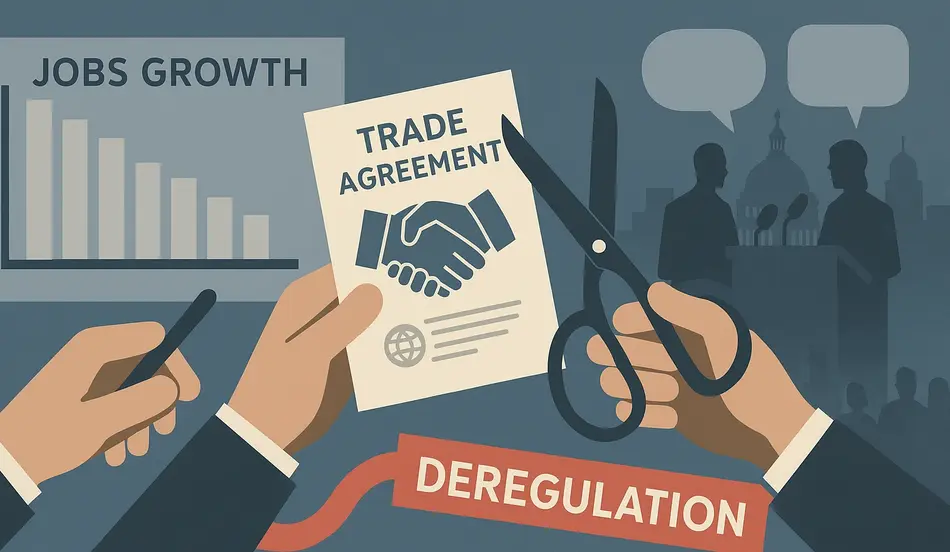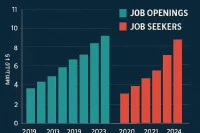The latest U.S. jobs payroll report delivered an unexpected shock to economists and investors alike, coming in below all estimates in the Bloomberg survey. The headline number showed just 73,000 new U.S. jobs created in the most recent month, while revisions to previous months wiped out 258,000 positions—underscoring concerns that America’s labor market momentum may be fading.
The sharp slowdown contrasts with stronger job creation seen earlier this year and has triggered a heated political debate. The administration of President Donald Trump insists that the labor market remains healthy and that its trade and tariff policies, deregulatory push, and tax reforms will pay off in the long term. Critics, however, argue that restrictive immigration policies are reducing available workers and directly curbing job growth.
The Headline Numbers
The report’s top-line figure—73,000 jobs—was well below consensus expectations of around 150,000. More troubling for analysts were the downward revisions for the two previous months, which showed that hiring was weaker than initially reported.
Still, administration officials attempted to put a positive spin on the figures. “We still have a net positive, almost a half a million new jobs since the president took office,” Labor Secretary [Name] said in an interview. “We’ve seen gains in health care, in construction, and while the revisions are disappointing, they were largely in education and seasonal workforce areas.”
The unemployment rate held steady at 3.9%, wage growth edged higher, and consumer confidence remained solid. For the White House, those factors signal resilience despite the weaker headline.
Immigration Policy at the Center of the Debate
For critics, the slowdown is not surprising. They argue it is the predictable outcome of the administration’s deliberate choice to limit immigration and tighten visa rules.
“We had a three-month run rate of 150,000 jobs. Now it’s closer to 37,000,” one analyst pointed out. “This looks like a direct result of conscious policies to restrict immigration.”
In other words, fewer workers entering the country means a smaller pool of labor, especially in industries that rely heavily on immigrant workers such as construction, hospitality, and agriculture. Some economists warn that this could create long-term bottlenecks in sectors already struggling to fill positions.
Administration officials reject this framing. “The president is delivering on trade deals and tariff reforms,” the Labor Secretary countered. “Businesses now feel certainty. The table has been set, and investments are happening. What we need now is for the Federal Reserve to cut interest rates so businesses can invest further.”
Industry Breakdown: Who’s Hiring, Who’s Firing
The report showed clear divides across industries:
- Health care: Remains the strongest engine of job creation. Without it, payroll growth would have been negative for three consecutive months. Demand for nurses, home health aides, and hospital staff continues to surge as America’s population ages.
- Construction: Still adding jobs, fueled by federal infrastructure spending and ongoing housing projects.
- Manufacturing: A weak spot. The sector shed 11,000 jobs in July alone and has lost 28,000 jobs in the past six months. Many factories are struggling with higher costs, tariff uncertainty, and slower global demand.
- Federal Government: Jobs declined as the administration pushes to reduce federal payrolls. Local economies, however, saw more hiring.
The mixed picture highlights the uneven nature of the recovery and the challenge of sustaining momentum across all sectors.
The Manufacturing Question
Manufacturing’s continued decline has drawn particular concern. Once a centerpiece of Trump’s economic agenda, factory jobs have not rebounded in the way many hoped.
When asked what policies are in place to revive the sector, officials pointed to new trade agreements with Japan and the European Union. “It’s that certainty we have to give businesses,” the Labor Secretary explained. “We are also working with community colleges, technical schools, and businesses to get workers skilled up quickly.”
The administration argues that many firms simply need a “quarter turn” of additional training to make workers ready for the jobs available. To that end, the Department of Labor is collaborating with the Department of Education, state governments, and employers to set up workforce training pipelines.
Check Out Entry-Level Jobs Today
With new training pipelines and education partnerships, more entry-level opportunities are opening across industries. Start your career journey on WhatJobs—find roles that match your skills and help you grow into the future workforce.
Search Entry-Level Jobs →Deregulation and the “One Big, Beautiful Bill”
Another pillar of the administration’s economic policy is deregulation. According to the Department of Labor, 63 deregulatory actions have been carried out in just six months, compared with 130 over the entirety of Trump’s first four years.
Officials say the goal is modernization and cost-cutting, making government an “ally for the American workforce, not an adversary.”
The administration also continues to tout the passage of what Trump has called the “one big, beautiful bill,” a sweeping package of tax changes and trade measures. Supporters say it provides businesses with long-term certainty, encouraging them to invest in equipment, facilities, and employees.
With this framework in place, the administration believes businesses now have the confidence to plan ahead, even amid a cooling economy.
Interest Rates and the Federal Reserve
Beyond trade and regulation, officials have a clear message for the Federal Reserve: cut interest rates.
“I talked to businesses just yesterday,” the Labor Secretary said. “They’ve invested in American workers, they want to invest more, but they are concerned with borrowing costs. We should all be rowing in the same direction, and Jerome Powell should lower rates.”
Markets appear to agree. Treasury yields fell sharply after the weak jobs report, with the 10-year note down to 4.25%, suggesting investors are betting that the Fed will cut rates at its next meeting.
Lower borrowing costs could give firms the breathing room they need to expand, hire, and invest—though skeptics argue that monetary policy alone cannot fix deeper structural challenges in the economy.
Businesses React
Small and medium-sized businesses are watching closely. Many welcomed the tax breaks in the administration’s bill but remain wary about the outlook.
One business owner described the environment as “stable but uncertain.” On one hand, deregulation and tax relief make it easier to invest. On the other, fluctuating tariffs and shifting immigration rules add new complexities to long-term planning.
Still, the administration believes confidence is improving. “I’ve visited 20 states,” the Secretary said. “Business owners are excited. They understand their marching orders now: invest in the American worker.”
Invest in the American Worker
In times of uncertainty, one move drives stability—hiring. Post your job on WhatJobs and connect with skilled professionals eager to build the future of American business with you.
Post a Job Now →Outlook for 2025
Looking ahead, the administration projects continued growth, though perhaps at a slower pace than the immediate post-pandemic rebound.
“Consumer confidence is up, wage growth is up, unemployment is steady,” the Secretary said. “We want to see better numbers, but with trade certainty, deregulation, and lower interest rates, we believe job growth will strengthen again.”
Economists remain cautious. Without immigration to replenish the workforce, they warn, long-term growth could be capped. Others note that manufacturing is unlikely to rebound quickly, even with trade deals, given global competition and automation trends.
For now, the U.S. labor market appears to be entering a fragile phase—caught between the momentum of past gains and the challenges of a cooling economy.
FAQ: U.S. Jobs Report and Policy Impact
1. Why were the latest U.S. job numbers weaker than expected?
The slowdown was partly due to revisions in education and seasonal employment. Critics argue that tighter immigration policies are also reducing the available workforce.
2. Which industries are adding jobs and which are losing them?
Health care and construction are growing strongly. Manufacturing is shrinking, with nearly 30,000 jobs lost in six months. Federal jobs are declining, while local hiring is stronger.
3. How is the administration responding to slower job growth?
The administration points to new trade agreements, workforce training programs, and deregulation. Officials are also pressing the Federal Reserve to cut interest rates.
4. What does the “one big, beautiful bill” mean for businesses?
It introduced tax cuts and trade reforms designed to give businesses certainty, reduce costs, and encourage long-term investment in workers and facilities.




